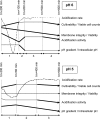Fermentation pH influences the physiological-state dynamics of Lactobacillus bulgaricus CFL1 during pH-controlled culture
- PMID: 19429565
- PMCID: PMC2704822
- DOI: 10.1128/AEM.02725-08
Fermentation pH influences the physiological-state dynamics of Lactobacillus bulgaricus CFL1 during pH-controlled culture
Abstract
This study aims at better understanding the effects of fermentation pH and harvesting time on Lactobacillus bulgaricus CFL1 cellular state in order to improve knowledge of the dynamics of the physiological state and to better manage starter production. The Cinac system and multiparametric flow cytometry were used to characterize and compare the progress of the physiological events that occurred during pH 6 and pH 5 controlled cultures. Acidification activity, membrane damage, enzymatic activity, cellular depolarization, intracellular pH, and pH gradient were determined and compared during growing conditions. Strong differences in the time course of viability, membrane integrity, and acidification activity were displayed between pH 6 and pH 5 cultures. As a main result, the pH 5 control during fermentation allowed the cells to maintain a more robust physiological state, with high viability and stable acidification activity throughout growth, in opposition to a viability decrease and fluctuation of activity at pH 6. This result was mainly explained by differences in lactate concentration in the culture medium and in pH gradient value. The elevated content of the ionic lactate form at high pH values damaged membrane integrity that led to a viability decrease. In contrast, the high pH gradient observed throughout pH 5 cultures was associated with an increased energetic level that helped the cells maintain their physiological state. Such results may benefit industrial starter producers and fermented-product manufacturers by allowing them to better control the quality of their starters, before freezing or before using them for food fermentation.
Figures




Similar articles
-
Dynamic analysis of Lactobacillus delbrueckii subsp. bulgaricus CFL1 physiological characteristics during fermentation.Appl Microbiol Biotechnol. 2008 Dec;81(3):559-70. doi: 10.1007/s00253-008-1699-4. Epub 2008 Sep 18. Appl Microbiol Biotechnol. 2008. PMID: 18800182
-
Acidification improves cryotolerance of Lactobacillus delbrueckii subsp. bulgaricus CFL1.J Biotechnol. 2007 Feb 20;128(3):659-67. doi: 10.1016/j.jbiotec.2006.11.012. Epub 2006 Nov 25. J Biotechnol. 2007. PMID: 17194497
-
Acid adaptation of Lactobacillus delbrueckii subsp. bulgaricus induces physiological responses at membrane and cytosolic levels that improves cryotolerance.J Appl Microbiol. 2008 Oct;105(4):1071-80. doi: 10.1111/j.1365-2672.2008.03848.x. Epub 2008 May 21. J Appl Microbiol. 2008. PMID: 18498349
-
Evaluation of different conditions to enhance the performances of Lactobacillus pentosus OM13 during industrial production of Spanish-style table olives.Food Microbiol. 2017 Feb;61:150-158. doi: 10.1016/j.fm.2016.08.007. Epub 2016 Sep 8. Food Microbiol. 2017. PMID: 27697165
-
Enhancement of gamma-aminobutyric acid (GABA) levels using an autochthonous Lactobacillus futsaii CS3 as starter culture in Thai fermented shrimp (Kung-Som).World J Microbiol Biotechnol. 2017 Aug;33(8):152. doi: 10.1007/s11274-017-2317-3. Epub 2017 Jul 3. World J Microbiol Biotechnol. 2017. PMID: 28674926
Cited by
-
Study on the extraction, antioxidant and prebiotic activity of the polysaccharides from the fruits of Phyllanthus emblica L.Front Nutr. 2025 Jul 14;12:1607077. doi: 10.3389/fnut.2025.1607077. eCollection 2025. Front Nutr. 2025. PMID: 40727698 Free PMC article.
-
Potential of Flow Cytometric Approaches for Rapid Microbial Detection and Characterization in the Food Industry-A Review.Foods. 2021 Dec 15;10(12):3112. doi: 10.3390/foods10123112. Foods. 2021. PMID: 34945663 Free PMC article. Review.
-
Fermentation Characteristics of Fermented Milk with Streptococcus thermophilus CICC 6063 and Lactobacillus helveticus CICC 6064 and Volatile Compound Dynamic Profiles during Fermentation and Storage.Molecules. 2024 Mar 12;29(6):1257. doi: 10.3390/molecules29061257. Molecules. 2024. PMID: 38542894 Free PMC article.
-
Application of response surface methodology to enhancement of biomass production by Lactobacillus rhamnosus E/N.Braz J Microbiol. 2011 Oct;42(4):1485-94. doi: 10.1590/S1517-838220110004000035. Epub 2011 Dec 1. Braz J Microbiol. 2011. PMID: 24031782 Free PMC article.
-
Volatile Flavor Compounds Profile and Fermentation Characteristics of Milk Fermented by Lactobacillus delbrueckii subsp. bulgaricus.Front Microbiol. 2019 Sep 18;10:2183. doi: 10.3389/fmicb.2019.02183. eCollection 2019. Front Microbiol. 2019. PMID: 31620117 Free PMC article.
References
-
- Adamberg, K., S. Kask, T. M. Laht, and T. Paalme. 2003. The effect of temperature and pH on the growth of lactic acid bacteria: a pH-auxostat study. Int. J. Food Microbiol. 85:171-183. - PubMed
-
- Amrane, A., and Y. Prigent. 1999. Differentiation of pH and free lactic acid effects on the various growth and production phases of Lactobacillus helveticus. J. Chem. Technol. Biot. 74:33-40.
-
- Barreto, M. T. O., E. P. Melo, J. S. Almeida, A. M. R. B. Xavier, and M. J. T. Carrondo. 1991. A kinetic method for calculating the viability of lactic starter cultures. Appl. Microbiol. Biotechnol. 34:648-652.
-
- Béal, C., and G. Corrieu. 1991. Influence of pH, temperature, and inoculum composition on mixed cultures of Streptococcus thermophilus 404 and Lactobacillus bulgaricus 398. Biotechnol. Bioeng. 38:90-98. - PubMed
-
- Béal, C., P. Louvet, and G. Corrieu. 1989. Influence of controlled pH and temperature on the growth and acidification of pure cultures of Streptococcus thermophilus 404 and Lactobacillus bulgaricus 398. Appl. Microbiol. Biotechnol. 32:148-154.
Publication types
MeSH terms
Substances
LinkOut - more resources
Full Text Sources
Research Materials
Miscellaneous

